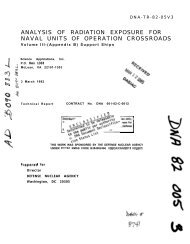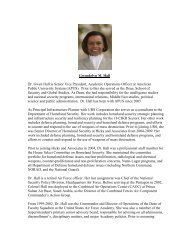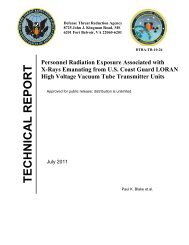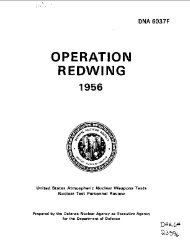Shield - Defense Threat Reduction Agency
Shield - Defense Threat Reduction Agency
Shield - Defense Threat Reduction Agency
You also want an ePaper? Increase the reach of your titles
YUMPU automatically turns print PDFs into web optimized ePapers that Google loves.
Between 1945 and the signing of the Limited Test<br />
Ban Treaty in 1963, the United States used two<br />
nuclear weapons<br />
2 / the shield / fall 2011<br />
to end WWII and tested hundreds<br />
more on land, sea and in the air. Decades later, the<br />
<strong>Defense</strong> <strong>Threat</strong> <strong>Reduction</strong> <strong>Agency</strong> is charged with<br />
reconstructing those days and fi guring out who<br />
was exposed to what and helping our veterans<br />
in<br />
When an earthquake-triggered tsunami damaged a nuclear power<br />
plant in Fukushima, Japan, earlier this year, news of potential radiation<br />
leaks quickly became the lead story in the international media.<br />
Th e thousands of people killed, the thousands more missing, entire<br />
villages that had been literally wiped off the map, damage in the billions<br />
of dollars – they all took second place to a (undetermined at the<br />
time) possible leak of an unknown amount of potentially threatening<br />
radiation.<br />
Any other story with as many unknown variables would never make<br />
front page news, much less when a disaster of truly epic proportions<br />
had just taken place, but precisely because of its unknowns – you<br />
can’t smell it, see it, taste it or hear it – the term radiation can cause<br />
a lot of confusion and panic and cause dramatic and extreme reactions,<br />
some rightly justifi ed, some completely unfounded.<br />
Unleashing the atom... and some radiation<br />
Between 1945, when the world’s fi rst atomic bomb was tested at the<br />
Trinity Test site, and 1962, the United States completed more than<br />
300 above ground tests of nuclear weapons, ranging in size from the<br />
watermelon-sized, low yield, almost backpack-portable Davy Crockett<br />
to the massive 15 megaton CASTLE BRAVO shot. Set off in<br />
remote locations – mostly the desert of the American Southwest or<br />
the Pacifi c Ocean – nuclear weapons testing was an intensive ordeal<br />
involving thousands of people. Several tests involved troops maneuvering<br />
through target areas after the warheads detonated. Setting<br />
up equipment and targets on land and sea prior to tests and decontamination<br />
of target ships that did not sink, retrieval of recording<br />
equipment, and observation of tests took a lot of manpower – about<br />
235,000 troops and Department of <strong>Defense</strong> civilians over the years.<br />
In addition to the tests, about a quarter-million U.S. troops and<br />
DoD civilians were part of the post-war occupation of Hiroshima<br />
and Nagasaki, the targets of the atomic bombs Fat Man and Little<br />
Boy. Add in the American POWs in Japan and there were almost<br />
half a million people that could have been exposed to elevated levels<br />
of radiation that had the potential to cause health problems later in<br />
life – and therein lies part of the riddle: is the “potential” a .0001%<br />
or 10% chance of getting cancer? And is “later” 10 years later, 50<br />
years later – or never?<br />
Solving the riddle<br />
In 1977, long after the United States stopped testing nuclear weapons<br />
above ground, a retired soldier fi led a claim with the Department of<br />
Veterans Aff airs for disability benefi ts. Th e former Army noncommissioned<br />
offi cer attributed his leukemia to radiation received during<br />
a 1957 nuclear weapons test. Th at same year, the media reported<br />
on an unusually high number of veterans with leukemia that had<br />
one thing in common – they had participated in a nuclear test in<br />
Nevada. Th ey were part of the 490,000 people known informally<br />
as ‘atomic vets.’<br />
It became apparent that some of this country’s atomic vets might be<br />
suff ering from diseases that were a result of exposure to elevated radiation<br />
levels. Th e United States military was now facing two large issues:<br />
providing benefi ts and care to atomic vets that have medical issues









